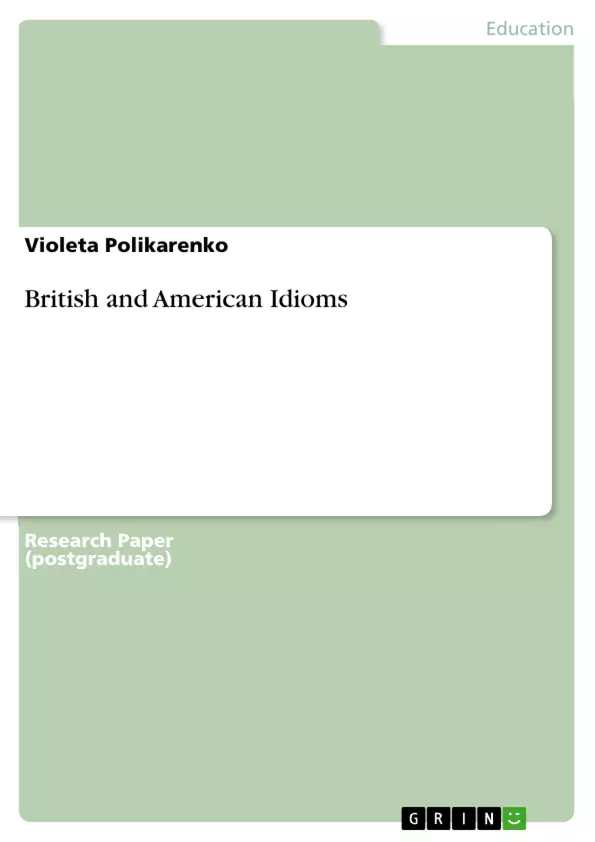People use idioms to express something that other words do not express as clearly or as cleverly. Often they use an image or symbol to describe something as clearly as possible and that make our point as effectively as possible.
An idiom is a group of words which, when used together, has a different meaning from the one which the individual words have. Many idioms are colourful and curious, and their origins are impossible to trace.
Inhaltsverzeichnis (Table of Contents)
- Introduction
- What an idiom is
- Understanding and using of idioms
- Idioms reflecting events of the 17th century
- Idioms referring to the 18th century
- Idioms to the 19th century
- Idioms referring to the 20th century
- Differences between American English and British English
- Influence of the American English on the world of idioms
- Conclusion
Zielsetzung und Themenschwerpunkte (Objectives and Key Themes)
The objective of this research paper is to understand and explain the differences between British and American English idioms. It aims to explore what constitutes an idiom, how idioms are used, and the historical context influencing their development.
- Definition and characteristics of idioms
- The use and understanding of idioms in different contexts
- Historical evolution of idioms in British and American English
- Differences between British and American idioms
- The influence of American English on the global usage of idioms
Zusammenfassung der Kapitel (Chapter Summaries)
Introduction: The introduction establishes the importance of idioms in English language fluency, highlighting their complexity and the challenges they present to non-native speakers. It emphasizes the need to understand idioms to effectively communicate in English and sets the stage for exploring the nuances of British and American idioms.
What an idiom is: This chapter defines idioms, distinguishing them from literal phrases. It discusses their metaphorical nature, fixed grammatical forms, and origins in spoken language. The chapter emphasizes the significant number of idioms in English and their contribution to the richness and complexity of the language while also acknowledging the difficulties they can pose for learners.
Understanding and using of idioms: This chapter delves into the practical aspects of idiom usage, exploring the challenges non-native speakers face in understanding and applying them appropriately. It stresses the importance of considering context, audience, and cultural factors when using idioms. The chapter argues that successful idiom usage enhances communication and social interaction with native speakers, emphasizing the benefits of immersion and practice in improving idiom comprehension and application.
Schlüsselwörter (Keywords)
British English, American English, idioms, idiomatic expressions, language learning, cultural context, historical linguistics, communication, metaphor, figurative language.
Frequently Asked Questions: A Comprehensive Language Preview of British and American English Idioms
What is the main focus of this research paper?
The research paper focuses on understanding and explaining the differences between British and American English idioms. It explores what constitutes an idiom, how idioms are used, and the historical context influencing their development. The paper also examines the influence of American English on the global usage of idioms.
What topics are covered in the Table of Contents?
The Table of Contents includes an introduction, a definition of idioms, their usage, idioms reflecting events from the 17th to the 20th centuries, differences between American and British English idioms, the influence of American English on idioms globally, and a conclusion.
What are the key objectives and themes of the research?
Key objectives include defining and characterizing idioms, exploring their usage in different contexts, tracing their historical evolution in British and American English, identifying differences between British and American idioms, and analyzing the influence of American English on global idiom usage.
What are the chapter summaries?
The introduction highlights the importance of idioms and the challenges they present to non-native speakers. The chapter on defining idioms distinguishes them from literal phrases and discusses their metaphorical nature and origins. The chapter on idiom usage explores the practical challenges non-native speakers face and emphasizes the importance of context and cultural factors. Further chapters delve into the historical evolution of idioms across different centuries, specifically focusing on British and American English.
What keywords are associated with this research?
Keywords include British English, American English, idioms, idiomatic expressions, language learning, cultural context, historical linguistics, communication, metaphor, and figurative language.
What is the overall goal of the study?
The overall goal is to provide a comprehensive understanding of idioms in both British and American English, focusing on their differences, historical development, and impact on global communication.
Who is the intended audience for this research?
The intended audience includes students, researchers, and anyone interested in the nuances of the English language, particularly those focusing on idioms and their cultural and historical significance.
What makes this preview comprehensive?
The preview's comprehensiveness stems from its inclusion of the title, table of contents, objectives and key themes, chapter summaries, and keywords. This structure provides a clear and concise overview of the research paper's scope and content.
- Quote paper
- Violeta Polikarenko (Author), 2010, British and American Idioms, Munich, GRIN Verlag, https://www.grin.com/document/169180



